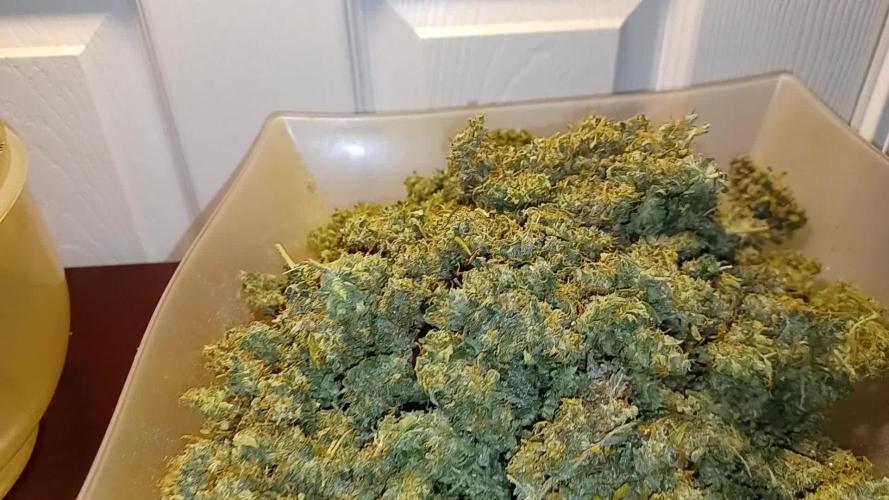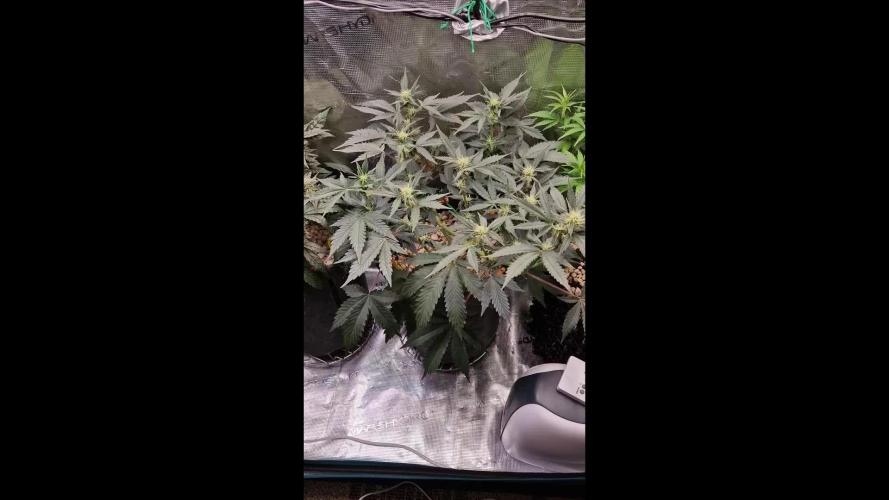The Grow Awards 2026 🏆 































Likes
Comments
Share


@Cultivandomedicinanatural
Follow
Es una variedad fácil de cultivar y muy agradecida, el peso que pongo arriba no es en mojado si no en seco. He sacado una media de 42,3 g por planta. También tanta cantidad es debido a que son muchas plantas para un metro cuadrado, pero se que el foco, los buenos nutrientes y la magnífica cepa como es green poison de sweet seeds ha hecho la mayoría del trabajo. La plantaría más veces, además cuando había alguna deficiencia corregía bastante rápido asique muy satisfecho con el resultado y más que satisfecho con todo lo elegido desde semilla hasta nutrientes y focos. Una planta de lujo para poder desconectar de los días duros y con un sabor exquisito. Buenos humos familia! espero que os guste este primer diario!
Likes
20
Share


@Roberts
Follow
She grew well for the little time I spent with her. She grew fast as upping my room temps a few degrees sped the process up. She has a good smell and I will be back to update on a smoke report in a few months once it is dried, cured, and trimmed. Thank you, Medic Grow, and ILGM. 🤜🏻🤛🏻🌱🌱🌱
Thank you grow diaries community for the 👇likes👇, follows, comments, and subscriptions on my YouTube channel👇.
❄️🌱🍻 Happy Growing 🌱🌱🌱
https://youtube.com/channel/UCAhN7yRzWLpcaRHhMIQ7X4g.
Likes
21
Share


@Budhunter
Follow
P. Punch is probably the one is going to be harvest first and it’s frosty. Gorilla punch is a really nice looking plant. Mimosa cake is the largest but the buds are thin. Hopefully they get fat 🙏🏼💥
Happy grow folks
Likes
8
Share


@UnitedStrainsGermany
Follow
Wir sind jetzt am letzten Drittel angelangt ich denke es handelt sich um etwa 21 Tagen , jetzt schon riecht es unverschämt gut nach tropical 🍹 oder Mandarin Banana aufjeden full.
Likes
7
Share


@Chubbs
Follow
420Fastbuds-FBA2504
I'm excited as it's tester time. Germination week is complete. I planted 3 seeds and had all 3 sprout within 48hrs of being in the soil. I do soak them for 48hrs in a glass of water before planting. I can't wait to see what the weeks to come will have in store. Happy Growing
Likes
44
Share


@Aedaone
Follow
The temperatures, humidity, and watering volume(if measured) in grow conditions are all averaged for the week. The pH is soil pH. Any watering done by me is well water which is 7.6 pH and 50° F. Any listed nutrients are ml/gallon of soil top dressed.
Day 1 we had high temperature of 85 and sunny skies. I watered 3-5 gallons from the hose. I added 45 ml coop poop and 50 ml plant tone. I spread the dry fertilizer evenly across the top of the soil.
Day 2 we had high temperature of 87°F with partly cloudy to cloudy skies. I watered 3-4 gallons from the hose. I added 100 ml of blood meal spread evenly across the top of the soil.
Day 3 We had a high temperature of 85°F. It rained the previous night and intermittently raining and thunderstorms today. The rain is watering today.
Day 4 we had a high temperature of 73°F and all day rain. The rain was what remained of hurricane Beryl. There was a lot of wind up to 20 miles per hour. These girls handled it and loved the rain.
Day 5 we had clear sunny skies and a high temperature of 85°F. I fed 150 ml feather meal and 45 ml Coop Poop. I watered 3-5 gallons from the water hose.
Day 6 we had a high temperature of 86°F and partly cloudy skies. Plants #1, that developed powdery mildew on its lower leaves, began treatment with Arber organic biofungicide. I'll continue that for 5 days. I ran the fertilizer a little hot the girls are clawing and super dark green this evening
Day 7 we had a high temperature of 85 with partly cloudy skies.
This week was a success. We got a touch of powdery mildew on the #1 plant. It's on the bottom leaves. I'll continue to treat that with Arber. Both of these girls began flower the last couple of days this week. About 9 weeks from now we should have some big old beautiful buds.
Likes
4
Share


@Venabr96
Follow
Começando a floraçao. As luzes foram trocadas para uma CFL 200W 8k. Ela ira terminar de crescer no modo de floraçao e ira acompanhar sua irma nesta jornada ( ver outro diario )
Likes
20
Share


@Santica_Garden
Follow
WIFI PUNCH by Growers Choice, another strain I am excited about trying, I did try this strain before but had a terrible germination that time so I ended up scrapping them.
But this time around things are going great 👍🏾🔥😎
Likes
9
Share


@GYOweed
Follow
To my haters: I love oxygen, so put a bag over your heads.
Temps are dippin.
They drink half gal a day!
Hooo wee mofos so this week i got too high and over corrected ph up and down a medium bap cytokinin spray basically did what i want stunt height but also kinda burned it 😅
The trichomes did go bonkers so i dunno. Seems kush mints bottom right doesnt wanna move fast.
Likes
8
Share


@GreenForce
Follow
Hey Growers,
Day 1 of Week 10
Two ladys harvested today you can see in fotos how they look in my opinion Amazing Hahah (but im the father lol).
Purple one its like a mix of exótic fruits
The orange one its like a a cream of a fruit.
Both seens very sweet!!
Soon i Will share strains!!
The another two ladys more sativas i think , looks like they need around more 10 days lets us see.
The taller one smeels like gasy citrus, And the another one its a mix of strwaberry And another touch that I dont discover yet.
Thank you all.
Nice week 4 everybody!!
_GrF_
Likes
2
Share


@Theia
Follow
ve repotted into her final 15l auto pot.
The procedure I used is as follows.
Items needed..
Clay pebbles
Hydro coco 60/40 clay pebbles/Coco.
Silicium Flash
Startrex
Mycrotrex
Bactrex
And of course Bio tablets X2.
15l of hydro coco was mixed with 25g of Silicium Flash and 25g of Startrex. Mixed up well to form the main substrate.
I filled the autopots to a depth of 5cm with clay pebbles and then layered up the amended substrate making a nice hole for my 300ml nursery pots.
Into this hole I sprinkled in 5g of Mycrotrex and then dropped the seedling in.
This then gets 2 biotabs pushed 5-8cm into the substrate and 1l of water mixed with 5ml of Bactrex
I need to top feed the autopots for a couple of weeks so the root system can establish before I transfer to my flower room and the gravity feeding trays..🤘🏼👍🏼
I'm keeping temps at a constant 25c and lights are on 24hrs a day. Rh is sitting around 65%.it too low hence the domes but then it goes too high. I'm going to run a couple of days with the 65% but vpd over 1 is a bit high for so early.. we shall see.
I'm more than happy with the purple punch. Considering when she was a sprout she grew out of her Coco plug and I found her flat on the floor...She is doing great. I'm a little concerned she is getting too much light. The others are all happy but punchy looks like she is a bit stumpy compared to the others. I've moved her to a side position in the tent so she gets a little less direct photons..
Likes
16
Share


@Rinna
Follow
I’ll update ya’ll on the smells and tastes after drying and curing! So far both are packed with ice and smell very potent, a little overpowering still, so I want to give it some time before they’re cures and can show their true terpene profile!
Likes
Comments
Share


@GERGrowDesigns
Follow
Welcome to Gem Week of Fast Buds Apple Strudel Auto
I'm excited to share my grow journey with you from my
FastBuds Project . It's going to be an incredible ride, full of learning, growing, and connecting with fellow growers from all around the world!
For this Project , I’ve chosen the Feminized Auto strain Apple Strudel:
Here’s what I’m working with:
• 🌱 Tent: 120x60x80
• 🧑🌾 Breeder Company: Fast buds
• 💧 Humidity Range: 90
• ⏳ Flowering Time: 9-10 Weeks
• Strain Info: 29%THC
• 🌡️ Temperature: 26
• 🍵 Pot Size: 0.1
• Nutrient Brand: Hy-Pro
• ⚡ Lights : 600W x 2
A huge thank you to Fast Buds for allowing me to try my Best with this amazing collection from Automatic and Photo Strains they managed to Sponsore . Big thanks for supporting the grower community worldwide! Your genetics and passion speak for themselves!
I would truly appreciate every bit of feedback, help, questions, or discussions – and of course, your likes and interactions mean the world to me as I try to stand out in this exciting competition!
Let’s grow together – and don’t forget to stop by again to see the latest updates!
Happy growing!
Stay lifted and stay curious!
Peace & Buds!
Likes
29
Share


@BioGrowKing
Follow
Die Woche ist wie immer normal verlaufen, auch sie ist schön am blühen :)
Gute 5 cm gröser geworden <<
Bis nächste Woche 👍
Likes
3
Share


@MicroHidroGrow
Follow
Día 16. Por ahora las plantas siguen en proceso de estiramiento. Hoy hice una defoliación fuerte. Esta etapa me pone ansioso porque quiero ya empezar a ver los primeros pelos de las flores. Pero viene bastante lento el tema. Supongo que voy a tener que esperar un poco más que 10 semanas para la cosecha. Pero tampoco me desanimo.
Likes
32
Share


@BrediniGreeny
Follow
7/11/25
New week babieess😍😍!!!!
7/13/25
Ohhh baby, the Mephisto experiment is cooking so so good right now.
I’m actually kind of stunned at how things are evolving, especially with Forum Stomper, a.k.a. Stompy the Comeback Queen.
She had kind of a rocky start — I mean, cotyledons were looking funky, and she went all bush-mode on me: dense structure, super tight internodal spacing, real short-stack energy.
But oh no no, she wasn’t done. Fast forward to now... Stompy is a straight-up MONSTER. A chunky, thriving beast that just keeps getting bigger — and I know she’s not done yet.
She’s officially stretching into flower now. Not just hinting at it — nah, full flowering stretch is underway, and she’s reaching up like she just realized she’s got room to take over the whole tent. I love this part.
Today was watering day, and both girls got their special cocktails.
First up, Grapey.
She drank 4.4 liters of love, with her mix spiked up with BioBloom at 16 ml, Topmax at 12 ml, BioHeaven at 16 ml, Activera at 16 ml, Agamic at 12 ml, and a touch of CalMag at 3.5 ml.
She’s hitting flower hard now too, and this brew should set her up to swell up sweet and loud.
Going in: pH 6,23, PPM 510 Temp 22,5 °C
Runoff: pH 6,47, PPM 1350
Then we’ve got Stompy, the Comeback Queen.
She got 4 liters of her own nutrient-rich mix: BioBloom 12 ml, Topmax 10 ml, Activera 12 ml, BioHeaven 12 ml, Agamic 10 ml, CalMag 3.5 ml, and just a whisper of CicaMax at 0.3 ml to finesse that vigor.
Oh, and let’s not forget — she also got her guano top dress today. I scooped out one of my little measuring cups, sprinkled it in like fairy dust, and let nature do its thing.
This is going to kick the bloom engine into overdrive.
Going in: pH 6,22 PPM 485 Temp 22 °C
Runoff: pH 6,7 PPM 650
7/17/25
Today Grapey got 4.8 liters of water, going in pH at 6.0, PPM 88, temperature 21.2 degrees Celsius. Runoff was pH 6.8 and PPM 760.
Stompy got also 4.8 liters of water, pH going in at 6.0, PPM 106, temperature 21 degrees. Runoff came out pH 6.2 and PPM 2000. Goddamn 😅 but she seems okay with it.
I think the next watering will also be just plain water because she has enough there. I will see.😍





















